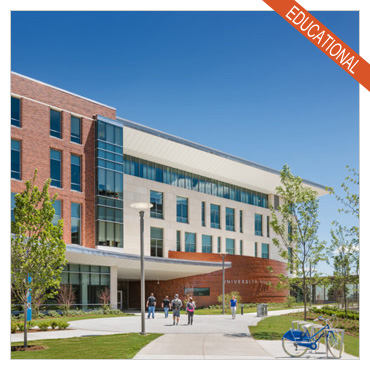|
|
|
FORM + FUNCTION |
 |
In spring 2016, an interdisciplinary academic building opened at the University of Massachusetts (UMass) Boston. Previously called General Academic Building 1, University Hall was designed to earn Silver under the Leadership in Energy and Environmental Design (LEED) program, and to overcome a number of acoustic challenges inherent to the space. This four-story, 17,651-m2 (190,000-sf) building features 2000 seats in 25 classrooms and lecture halls, as well as performing arts and laboratory space. It includes offices, a café, a student lounge, study areas, a 500-seat auditorium, a 150-seat recital hall, a 200-seat flexible theater, a dance studio, an acting lab, and practice rooms. This is in addition to a large atrium, which gives students and faculty views of the Boston Harbor.
|
|
|
|
Making choices with an impact on business processes can be complicated—particularly for manufacturers of building products continuously developing and introducing new materials to the market. To be approved for use in building construction, products need to be tested and evaluated to the requirements of building codes by appropriate third-party entities. In the rapidly evolving market for building materials, a manufacturer’s ability to demonstrate its products are code-compliant is critical to gaining approval for use in the thousands of jurisdictions across the nation. This code evaluation process can be time-consuming, and can impact timelines for introduction of products into the market.
|
|
EVENTS
February 12-15
AAMA 80th Annual Conference
American Architectural Manufacturers Association
Phoenix, Arizona
www.aamanet.org/events
March 16-21
RCI International Convention and Trade Show
RCI
Anaheim, California
rci-online.org
March 22-24
NASCC: The Steel Conference
American Institute of Steel Construction
San Antonio, Texas
www.aisc.org/NASCC
April 4-7
Coverings
Tile of Spain/Ceramics of Italy/TCNA
Orlando, Florida
www.coverings.com
May 24-28
CSC National Conference
Construction Specifications Canada
Kelowna, British Columbia
csc-dcc.ca/Conferences
|
|
|
VIEW LATEST ISSUE

|
|
TOP TRENDING ARTICLES |
In 2009, amid great fanfare and drama, the latest innovation in porcelain tile technology was formally announced and touted at the Cersaie exposition in Bologna, Italy. Multiple manufacturers had developed and launched new commercial tile lines that were bigger in size and thinner than anything else currently on the market. The halls of the exposition buzzed with the news of tiles as thin as 3 to 5 mm (0.12 to 0.2 in.) in various sizes and patterns with the potential to revolutionize the industry. The new technology was expected by some in the industry to bring tiling back into a leading position as a ‘green’ wall and floor finish. Thin tiles weighed less per square foot, could be produced and shipped with a lower net carbon footprint, and were produced with the consumption of fewer natural resources. Suddenly, thin was in.
|
Exterior soffits perform essential functions for ventilating, shading, and directing water away from a building. Regardless of geography or climate, exterior soffits are subjected to positive and negative wind loads. To protect occupants and their surroundings from damage, building codes have revised provisions for wind speeds and risk categories. Metal ceiling systems can meet the performance challenges of exterior soffits, as well as support buildings’ aesthetic and sustainability goals. Constructed mostly of aluminum, these assemblies are durable and do not deteriorate or deform.
 READ MORE READ MORE
|
Whether replacing a dated, inefficient hospital or renovating an historic mental health institution, window selection is an important consideration in creating a modern, healing environment. Behavioral healthcare facilities must minimize risks to patient safety, while maintaining a therapeutic environment. Windows provide daylighting and views to outside, helping create a more homelike and caring atmosphere for patients, while also contributing to staff health and well-being. Selecting windows in patient-accessible areas calls for careful consideration to ensure safety.
|
|
|
|
|
|

